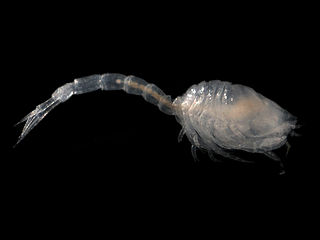Related Research Articles
Dr William Thomas Calman was a Scottish zoologist, specialising in the Crustacea. From 1927 to 1936 he was Keeper of Zoology at the British Museum.

Diastylis is a genus of crustaceans which belong to the family Diastylidae. It includes the following species:

Diastylidae is one of the eight most commonly recognised families of crustaceans of the order Cumacea. They are marine creatures especially common around the 30th parallel north.

Bodotriidae is a family of crustaceans belonging to the order Cumacea. Bodotriids have a worldwide distribution in shallow and deep waters. There are over 380 described species in over 30 genera, being the most diverse cumacean family. Their external morphology differs from other cumaceans by a combination of traits that independently are not unique to the family: the telson is fused to the last abdominal segment, the dorsal part of the mandible has a boat shape (naviculoid), exopods exist on the third maxilliped and the first peraeopod, and there is a uropodal endopod with one or two articles.

Pseudocumatidae is a family of crustaceans of the order Cumacea. Its members have a small, free telson. The uropods bear endopods on one segment. The males have two pairs of rather rudimentary pleopods and the flagella of the second antenna reach far beyond the pereon. In females the second antenna is much smaller than the first antenna.
Ceratocumatidae is a family of crustaceans of the order Cumacea. Ceratocumatidae have a small free telson. The endopods of the uropods are present on only one segment. Males have 5, 4 or 3 pairs of pleopods. All maxillipeds and some of the pereiopods bear exopods. The gill apparatus has no supporting gill plates.
Lampropidae is a family of cold-water crustaceans belonging to the order Cumacea. Members of Lampropidae are relatively easily recognised because they all at have at least three terminal setae on the telson. The telson is medium to large and not fused with the last segment of the pleon. The endopods of the uropods are present on all three members. In the males the flagellum of the second antenna reaches beyond the carapace; moreover, they possess pleopods. In the females the second antenna is somewhat shorter than the first. There are exopods on the third maxilliped and strongly reduced or absent on the third pereopods.
Leuconidae is a family of marine hooded shrimp. The family was established by Georg Ossian Sars in his 1878 study of Mediterranean cumaceans.
Nannastacidae is a family of crustaceans belonging to the order Cumacea. They have no free telson. The endopods of the uropods are present on one segment. There are exopods on the maxillipeds and generally one on pereopods 1–4 in males and 1–2 in females. In the females the second antenna is much shorter than the first. It contains the following genera:

Bodotria scorpioides is a species of crustacean belonging to the order Cumacea. They are found in the East Atlantic, the Mediterranean and the Black Sea. B. scorpioides does not possess a free telson. The first thoracic somite is too short to be seen from above, the second is longer. Both males and females have exopods on the first pereopods only.

Bodotria is a genus of crustaceans which belong to the family Bodotriidae. It includes the following species:

Petalosarsia is a crustacean genus in the family Pseudocumatidae, comprising three species:
Nannastacus is a genus of crustaceans in the order Cumacea. It contains the following species:

Diastylis laevis is a species of crustacean belonging to the order Cumacea and the genus Diastylis. It occurs from Skagerrak to the Côte d'Ivoire, but not in the Mediterranean Sea. It grows up to 11 millimetres (0.43 in) long.
Cyclaspis is a genus of cumacean crustaceans in the subfamily Bodotriinae, containing the following species:
Chalarostylis is a genus of cumacean crustaceans in the Lampropidae family, containing two species, including the one formerly placed in Dasylamprops, which is now considered a synonym of Chalarostylis.
Campylaspis is a genus of crustaceans in the order Cumacea. Species of Campylaspis have a "bulky" carapace, which makes up more than 40% of the animal's length, as well as distinctive features of the mouthparts. There are currently 170 recognised described species:
Dimorphostylis echinata is a species of crustacean from the Diastylidae family. The scientific name of this species was first published in 1962 by Gamo.

The clade Multicrustacea constitutes the largest superclass of crustaceans, containing approximately four-fifths of all described crustacean species, including crabs, lobsters, shrimps, woodlice, prawns, krill, barnacles, crayfish, copepods, amphipods and others. The largest branch of multicrustacea is the class Malacostraca.
References
| Wikispecies has information related to Cyclaspis elegans . |
- ↑ Les Watling (2010). L. Watling (ed.). "Cyclaspis elegans Calman, 1907". World Cumacea database. World Register of Marine Species . Retrieved August 13, 2010.